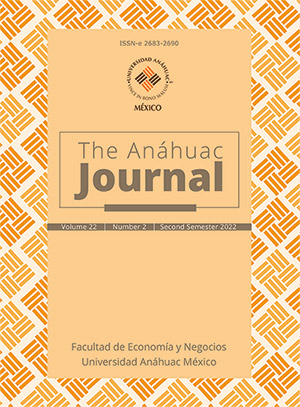Participación de la electricidad fotovoltaica en México hacia el año 2050: un estudio Delphi
Contenido principal del artículo
Resumen
El presente artículo tiene como objetivo realizar una prospectiva de la participación de la electricidad fotovoltaica (FV) en la canasta energética nacional hacia el año 2050. Para ello, se emplea el método Delphi, el cual se basa en la consulta a expertos en el sector FV. Dentro de los resultados obtenidos destacan: 1) el 89 % de los expertos opina que la participación de la electricidad FV crecerá en la mezcla energética de México; 2) la generación de electricidad FV enriquecerá al sistema eléctrico nacional por diversas ventajas como la implementación de proyectos de sistemas FV complejos y granjas FV interconectadas; 3) el 78 % de los expertos estima que habrá un efecto positivo en el producto interno bruto asociado a la generación de electricidad FV. El presente análisis sugiere que, para materializar las ventajas prospectadas hacia el año 2050 de la generación de electricidad FV, es urgente desarrollar un plan nacional que la impulse.
Downloads
Detalles del artículo
Sección

Esta obra está bajo una licencia internacional Creative Commons Atribución-NoComercial-CompartirIgual 4.0.
The Anáhuac Journal se distribuye bajo Licencia Creative Commons Atribución-NoComercial-CompartirIgual 4.0 Internacional.
Cómo citar
Referencias
Acuerdo de París. (2015). https://unfccc.int/sites/default/files/spanish_paris_agreement.pdf
Adler, M. y Ziglio, E. (1996). Gazing into the oracle: The Delphi Method and its application to social policy and public health. Jessica Kingsley Publishers.
Ashton, R. (1986). «Combining the judgments of experts: How many and which ones?». Organizational Behavior and Human Decision Processes, 38 (3), 405-414. https://doi.org/10.1016/0749-5978(86)90009-9 DOI: https://doi.org/10.1016/0749-5978(86)90009-9
Asociación Mexicana de Energía Solar (Asolmex). (2022). ASOLMEX. https://asolmex.org/
Beck, F. y Martinot, E. (2004). «Renewable Energy Policies and Barriers». En C. J. Cleveland (Ed.). Encyclopedia of Energy. Academic Press/Elsevier Science. http://biblioteca.cejamericas.org/bitstream/handle/2015/3308/Renewable_Energy_ DOI: https://doi.org/10.1016/B0-12-176480-X/00488-5
Policies_and_Barriers.pdf?sequence=1&isAllowed=y
Bolger, F. y Wright, G. (1994). «The quality of expert probability judgement: issues and analysis». Expert Systems, 11 (3), 149-158. https://doi.org/10.1111/j.1468-0394.1994.tb00321.x DOI: https://doi.org/10.1111/j.1468-0394.1994.tb00321.x
Espejo, C. y Aparicio, A. (2020a). «La producción de electricidad con energía solar fotovoltaica en España». Revista de Estudios Andaluces (39), 66-93. https://doi.org/10.12795/rea.2020.i39.04 DOI: https://doi.org/10.12795/rea.2020.i39.04
Espejo, C. y Aparicio, A. (2020b). «Orto y ocaso de la industria de fabricación de módulos fotovoltaicos en España». Lurralde (43), 393-438. https://www.ingeba.org/lurralde/lurranet/lur43/Lurralde_43_2020_Espejo.pdf DOI: https://doi.org/10.52748/lurralde.2020.43.91
Godet, M. (2000). La caja de herramientas de la prospectiva estratégica. Gerpa, Cuadernos de LIPS, núm 5. http://es.laprospective.fr/dyn/espagnol/bo-lips-esp.pdf
Goel, M. (2016). «Solar rooftop in India: Policies, challenges and outlook». Green Energy & Environment, 1(2), 129-137. https://doi.org/10.1016/j.gee.2016.08.003 DOI: https://doi.org/10.1016/j.gee.2016.08.003
Holland, J. y Campbell, J. (2005). Methods in development research: combining qualitative and quantitative approaches. Practical Action . DOI: https://doi.org/10.3362/9781780440286
International Energy Agency (IEA). (2020). World Energy Outlook 2020. P. IEA.
International Energy Agency (IEA). (2022). Special Report on Solar PV Global Supply Chains. IEA. http://www.iea.org
International Renewable Energy Agency (Irena). (2020). Renewable capacity statistics 2020. Irena. https://irena.org/publications/2020/Mar/Renewable-Capacity-Statistics-2020
Juárez-Luna, D. y Urdiales, E. (2022). «Generación de electricidad fotovoltaica: ignorada, en la práctica como en la teoría, en México». En Ruiz-Porras A. y Salas Durazo I. A. (eds.). Temas Contemporáneos de Investigación en Economía y Políticas Públicas II. Universidad de Guadalajara.
Ludwig, B. (1997). «Predicting the Future: Have you considered using the Delphi Methodology?». Journal of Extension, 35 (5). https://archives.joe.org/joe/1997october/tt2.php
Ma, D., Chang, C.-C. y Hung, S.-W. (2013). «The selection of technology for late-starters: A case study of the energy-smart photovoltaic industry». Economic Modelling, 35, 10-20. DOI: https://doi.org/10.1016/j.econmod.2013.06.030
Maradin, D. (2021). «Advantages and disadvantages of renewable energy sources utilization». International Journal of Energy Economics and Policy, 176-183. https://doi.org/10.32479/ijeep.11027 DOI: https://doi.org/10.32479/ijeep.11027
McNeece, J. (2020). Los Argumentos Económicos y Estratégicos para la Energía Renovable en México. Institute of the Americas / Wilson Center Mexico Institute.
Miklos, T. y Tello, M. (1991). Planeación prospectiva: una estrategia para el diseño del futuro. Limusa.
Muñiz, J. (2010). «Las teorías de los test: teoría clásica y teoría de respuesta a los ítems». Papeles del Psicólogo, 31(1), 57-66.
Parenté, F., Anderson, J., Myers, P. y O’brien, T. (1984). «An examination of factors contributing to delphi accuracy». Journal of Forecasting, 173-182. https://doi.org/10.1002/for.3980030205 DOI: https://doi.org/10.1002/for.3980030205
Prasad, A., Segarra, P. y Villanueva, C. (2019). «Academic life under institutional pressures for AACSB accreditation: insights from faculty members in Mexican business schools». Studies in Higher Education (Dorchester-on-Thames), 44 (9), 1605-1618. DOI: https://doi.org/10.1080/03075079.2018.1458220
Prescott, P. y Soeken, K. (1989). «The Potential Uses of Pilot Work». Nursing Research, 38 (1), 60. DOI: https://doi.org/10.1097/00006199-198901000-00015
Red Eléctrica. (2022). El Sistema eléctrico español. Red Eléctrica de España.
https://www.sistemaelectrico-ree.es/sites/default/files/2022-07/InformeSistemaElectrico_2021.pdf
Reguant-Álvarez, M. y Torrado Fonseca, M. (2016). «El método Delphi». Revista d’Innovació i Recerca en Educació, 9 (1), 87-102. https://doi.org/10.1344/reire2016.9.1916 DOI: https://doi.org/10.1344/reire2016.9.1916
Rodríguez-Calvo, A., Cossent, R. y Frías, P. (2017). «Integration of PV and EVs in unbalanced residential LV networks and implications for the smart grid and advanced metering infrastructure deployment». International Journal of Electrical Power & Energy Systems, 121-134. https://doi.org/10.1016/j.ijepes.2017.03.008 DOI: https://doi.org/10.1016/j.ijepes.2017.03.008
Sampaio, P. G. y González, M. O. (2017). «Photovoltaic solar energy: conceptual framework». Renewable and Sustainable Energy Reviews, 74, 590-601. https://doi.org/10.1016/j.rser.2017.02.081 DOI: https://doi.org/10.1016/j.rser.2017.02.081
Secretaría de Energía (Sener). (2017). Prospectiva del Sector Eléctrico 2017-2031.Sener.
Skulmoski, G., Hartman, F. y Krahn, J. (2007). «The Delphi Method for Graduate Research». Journal of Information Technology Education, 6 (1), 1-21. DOI: https://doi.org/10.28945/199
Tang, Y., Sun, H., Yao, Q. y Wang, Y. (2014). «The selection of key technologies by the silicon photovoltaic industry based on the Delphi method and AHP (analytic hierarchy process): Case study of China». Energy, 474-482. DOI: https://doi.org/10.1016/j.energy.2014.08.003
The World Bank. (2019). Global Solar Atlas. World Bank Group. https://globalsolaratlas.info/map

